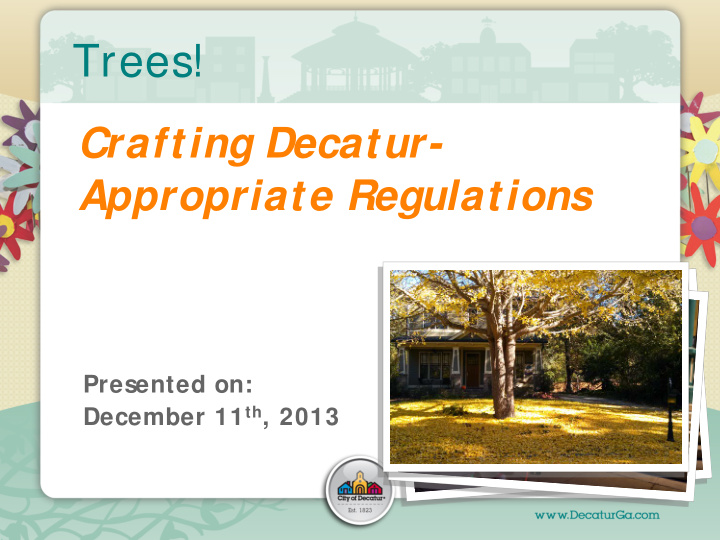



Trees! Crafting Decatur- Appropriate Regulations Presented on: December 11 th , 2013
Background 1989 1999 City passes 2008 first Tree Ordinance 2013 Preservation amended Draft of Ordinance new tree Ordinance ordinance amended developed
Background 12-month process to update land development regulations started in October 2013 Due to resident concerns, the following actions were taken by the City Commission; 1. 90 day moratorium on tree removal (Ends Jan 24) 2. Review of Tree Ordinance was expedited
S trategy Current Ordinance Final Recommendation 2008 Draft Ordinance to City Commission: Work Session : Jan 6 S takeholder Input Consideration for Adoption: Jan 21 Technical Expertise
Reasons for Updating the Tree Ordinance Aging tree population Urban/ human impacts to soil and trees Development pressures Maj ority of tree canopy is on private property New best management practices for tree conservation
Decatur’ s Trees by the Numbers Current canopy cover = approx. 45% Trend declining canopy coverage University of Georgia’s Natural Tree Canopy Coverage: NARSAL Resource Spatial Analysis 50.9% 50.4% 49.2% Laboratory (NARSAL) Canopy decreased 4.1% 46.8% in last 27 years Trend = 1% canopy loss ever 6- 7 years 1991 2001 2005 2008
Decatur’ s Trees by the Numbers Tree Canopy Coverage: Aerial Photos 2010 City of Decatur Study 45.7% 45.1% Analyzed tree canopy using aerial photographs. Provides more detail than NARS AL data. 2005 2010
Urban/ Human Impacts on Trees Restricted growing space Poor quality soils (compacted, no topsoil, low volume) Improper maintenance (mulching, pruning) Physical wounding (roots, trunk, crown) Environmental changes (soil, moisture, light, wind) S tress and insect and disease infestations
Large, Canopy Trees are at Risk Healthy, large canopy trees are very valuable and should be conserved whenever possible Large canopy trees are at the greatest risk for damage and death; once gone, the replacement of their canopy will take 50 to 100 years S pace is limited for the establishment of new large canopy trees; urban conditions and poor maintenance practices often make it difficult for trees to reach maturity
Development reduces soil quality (loss of topsoil, compaction) and can result in a loss of tree canopy cover. Trees planted on this property will struggle to survive due to poor soil conditions.
What Trees Need Good quality growing site with plenty of space for growth, above and below ground Proper planting (handling, depth, size of planting hole) and 3 years of post-planting maintenance to establish (water, mulch, inspections, and removal of staking and straps if tree was staked) Ongoing, routine maintenance (mulch, pruning, inspection, pest management) Protection of roots, trunk, and crown from time of planting through removal— throughout a tree’ s life Timely removal at end of useful service life
Tree Canopy Cover Goals Tree canopy cover is the ground area covered by the proj ection of the tree’ s canopy Tree canopies provide shade, cooling, oxygen, stormwater interception, and interception of pollutants including particulate matter A single mature canopy tree can provide 3,000 square feet or more of cover Tree root systems also provide uptake and filtration of water
What would it take to increase the canopy in 25 years? Current cover = 45% Increasing the canopy requires one-for-one replacement of all removed or fallen trees + 50% 55% 60% Canopy Canopy Canopy 3,600 7,320 10,980 trees trees trees
Tree canopy cover typically varies by property as shown below. Consider the contribution of benefits to the neighborhood by each of these properties. 100 % 34 70 % % 8%
Canopy goals in your backyard 1/4 Acre Lot 1/3 Acre Lot 45% coverage 3 large 4 large 60% coverage 4 large 4 large + 1 medium
Current Tree Ordinance All building and soil erosion control permits must be accompanied by a tree protection and replacement plan with the following exclusions: • Renovation proj ects on single-family and two-family homes • Construction and maintenance of public streets by government authorities • Diseased or dangerous trees Tree density is measured by using trunk diameter to calculate basal area (cross sectional area of trunk) City’ s tree consultant conducts plan review & inspection All plans must be prepared by a certified arborist, forester or landscape architect
Current Tree Ordinance Proj ects must have 30 tree density units per acre (15 for single-family residential) A portion of the required tree density must be met on-site through protection of significant trees If the tree consultant determines that a proj ect cannot meet the tree density requirement , payments for the balance are accepted by the City for the tree bank There is currently no protection for boundary trees
Tree Conservation Recommendations S et community tree canopy cover goals Focus on maintaining and replacing tree canopy cover on a site, in a neighborhood, and across the community Focus on the placement of trees where their function is maximized Require compliance with standards for soil quality, planting, pruning, mulching, watering, and other arboricultural practices Require compliance with standards for tree protection during construction for trees that will be conserved Allow for flexibility in the achievement of tree canopy cover requirements Maintain an option for contributions to the Tree Bank in lieu of fully meeting tree canopy cover requirements
Comments Posters located around the room Comment cards DecaturNEXT.com Final recommendation to City Commission: • Work Session : Jan 6 • Consideration for Adoption: Jan 21
Recommend
More recommend